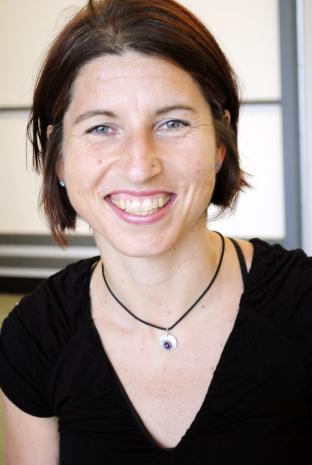
Time: 11:30AM EST - 12:30 PM EST
Background:
Bipolar disorder is a condition that involves the human brain. There is no easy access to brain tissue from living people. Using induced pluripotent stem cells offers the first opportunity to model the activity of brain and nerve cells from individuals with bipolar disorder. Samples from skin are ‘induced’ to form pluripotent stem cells that can subsequently be prompted to grow into nerve cells. Shortly after this technology was developed, the Prechter Bipolar Research Program expanded to include Sue O’Shea, PhD, Professor, in the Department of Cell and Developmental Biology who works on pluripotent stem cells. Individuals with a history of bipolar disorder and non-bipolar controls provided skin samples that were grown into stem cells and then nerve cells. Over the past decade this work has expanded to include a multisite collaboration with the University of Pennsylvania, the Salk Institute, Sanford Burnham Institute, and Janssen Pharmaceuticals. Several significant findings have included the consistent characteristic of premature excitability of nerve cells derived from individuals with bipolar disorder, the abnormal behaviors of astrocytes, and the apparent dysfunction of exosomes. These patterns are leading towards the identification of target pathways that may be suitable for pharmaceutical intervention.
Read more about the topic of this seminar:
Stem cells have become an essential component of the contemporary life sciences research toolbox, a cornerstone of basic, clinical and translational research throughout the world. The ability to derive stem cells from individuals with disease—either genetic or acquired—is helping us identify the origins of the condition and thereby what new approaches might be effective in treating it. Over the last decade we have built on the revolutions in stem cell biology that make it possible to derive pluripotent stem cells from somatic cells such as skin to study Bipolar Disorder.
In the Prechter Program we have taken two basic (overlapping) approaches to studying stem cells derived from patients with Bipolar Disorder. Because neuropsychiatric conditions typically lack viable cells for research discovery, the ability to derive stem cells from individuals diagnosed with Bipolar Disorder, differentiate them to target cells of the nervous system, then compare the behavior, gene and protein expression patterns of similar cells from unaffected controls has identified novel behaviors, as well as changes in chemical and electrical signaling between groups. We have demonstrated that prior exposure to the mainstay treatment for Bipolar Disorder, lithium, can return early neuronal signaling to control levels, providing a springboard to identify and test new interventions in other pathways.
Another approach is to study stem cells from patients carrying a mutation associated with the disorder; in our case an alteration in the CACNA1C gene which codes for a protein involved in the uptake of calcium into excitable cells. We have prioritized deriving stem cells from patients with Bipolar Disorder who also carry this mutation and have determined that these cells are electrophysiologically more active, and active earlier, than matched controls.
Stem cells can also be used to model more complicated brain activity. Because an imbalance in the activity of inhibitory vs excitatory neurons in the brain is often suggested to be involved in Bipolar Disorder, we have differentiated our cell lines into gabaergic and glutamatergic neurons to study how changes in the activity of these cells might be characteristic of or contribute to Bipolar Disorder.
In the course of our studies of gene expression differences between Bipolar vs control astrocytes (the supporting cells of the nervous system), we identified alterations in exosomes, small membrane bound vesicles that carry both growth factors and also remove toxic waste from target cells of the body. Considerable additional work has determined that exosomes derived from Bipolar patient astrocytes can alter the function of control neurons, and conversely, exosomes from control astrocytes improve function of Bipolar patient neurons. These results suggest a novel paradigm for understanding Bipolar Disorder. This research has benefited from a dynamic team approach that includes dedicated research scientists, clinical researchers and clinicians, and of course individuals who have lived with bipolar disorder.
These studies provide viable neurons and glial cells from individuals with Bipolar Disorder that should allow us to identify the cellular origins of this condition and help us more rapidly determine what medications might be effective, thereby providing another building block in the concept of personalized and regenerative medicine.
Scientific Abstract:
Characterization of stem cell-derived exosomes in bipolar disorder and their impact on recipient cells.
Schill D1*, Atilli D1*, DeLong CJ1, Campbell K1, Jiang G1, Navis B2, McInnis MG2, Yocum, A2, O’Shea KS1,2
1Department of Cell and Developmental Biology, 2Department of Psychiatry, University of Michigan Medical School, Ann Arbor MI 48109.
*These authors contributed equally to this work
Bipolar I Disorder (BP) is a serious, recurrent mood disorder that is characterized by alternating episodes of mania and depression. To identify novel approaches and pathways associated with BP, we have differentiated human induced pluripotent stem cells (iPSC) derived from BP and undiagnosed control (C) individuals to astrocytes and performed RNA-seq analysis. In comparing differentially expressed genes using hierarchical cluster analysis, “Exosome” was the most highly significant cluster identified. Exosomes are lipid membrane bound vesicles that carry proteins, miRNAs, and mRNAs, enabling cell to cell communication as well as the removal of toxic proteins from cells. However, little is known regarding what transcripts and proteins are carried from astrocytes to neurons, how they regulate biological functions of the recipient cell, and in turn how that may be altered in mood disorders. To examine the characteristics of BP and C exosomes, their cargo and interactions with neuronal cells, astrocytes were differentiated from BP and C iPSC lines. Supernatants from these cultures were collected; exosomes were isolated and characterized. Western blot analysis demonstrated the presence of exosomal markers and proteomic analyses identified 497 differentially expressed proteins. GO analysis identified: extracellular matrix components, signaling molecules and growth factors as well as several disease related proteins. Checkerboard analyses of the effects of exosomes on neuronal differentiation/function was carried out by addition of exosomes derived from BP and C astrocytes to BP and C developing cortical glutamatergic neurons. Interestingly, addition of BP astrocyte-derived exosomes to C glutamatergic neurons resulted in decreased synaptic density and alterations in Ca++ handling. Remarkably, addition of C astrocyte-derived exosomes to BP glutamatergic neurons rescued the synaptic density deficits. Proteomic analysis of exosomes isolated from peripheral blood of patients who contributed fibroblasts for stem cell derivation is currently underway. Given the current interest in clearing toxic proteins from the brain of patients with neurodegenerative conditions, exosomes may present a unique target in BP.
1U19MH106434-05
Plain English Summary: Stem Cells as Tools to Understand and Model Bipolar Disorder:
Stem cells have become an essential component of the contemporary life sciences research toolbox, a cornerstone of basic, clinical and translational research throughout the world. The ability to derive stem cells from individuals with disease—either genetic or acquired—is helping us identify the origins of the condition and thereby what new approaches might be effective in treating it. Over the last decade we have built on the revolutions in stem cell biology that make it possible to derive pluripotent stem cells from somatic cells such as skin to study Bipolar Disorder.
In the Prechter Program we have taken two basic (overlapping) approaches to studying stem cells derived from patients with Bipolar Disorder. Because neuropsychiatric conditions typically lack viable cells for research discovery, the ability to derive stem cells from individuals diagnosed with Bipolar Disorder, differentiate them to target cells of the nervous system, then compare the behavior, gene and protein expression patterns of similar cells from unaffected controls has identified novel behaviors, as well as changes in chemical and electrical signaling between groups. We have demonstrated that prior exposure to the mainstay treatment for Bipolar Disorder, lithium, can return early neuronal signaling to control levels, providing a springboard to identify and test new interventions in other pathways.
Another approach is to study stem cells from patients carrying a mutation associated with the disorder; in our case an alteration in the CACNA1C gene which codes for a protein involved in the uptake of calcium into excitable cells. We have prioritized deriving stem cells from patients with Bipolar Disorder who also carry this mutation and have determined that these cells are electrophysiologically more active, and active earlier, than matched controls.
Stem cells can also be used to model more complicated brain activity. Because an imbalance in the activity of inhibitory vs excitatory neurons in the brain is often suggested to be involved in Bipolar Disorder, we have differentiated our cell lines into gabaergic and glutamatergic neurons to study how changes in the activity of these cells might be characteristic of or contribute to Bipolar Disorder.
In the course of our studies of gene expression differences between Bipolar vs control astrocytes (the supporting cells of the nervous system), we identified alterations in exosomes, small membrane bound vesicles that carry both growth factors and also remove toxic waste from target cells of the body. Considerable additional work has determined that exosomes derived from Bipolar patient astrocytes can alter the function of control neurons, and conversely, exosomes from control astrocytes improve function of Bipolar patient neurons. These results suggest a novel paradigm for understanding Bipolar Disorder. This research has benefited from a dynamic team approach that includes dedicated research scientists, clinical researchers and clinicians, and of course individuals who have lived with bipolar disorder.
These studies provide viable neurons and glial cells from individuals with Bipolar Disorder that should allow us to identify the cellular origins of this condition and help us more rapidly determine what medications might be effective, thereby providing another building block in the concept of personalized and regenerative medicine.
Bibliography of Prechter – Tam Bipolar Stem Cell Collaboration:
Bame M, McInnis MG, O'Shea KS. MicroRNA alterations in induced pluripotent stem cell-derived neurons from bipolar disorder patients: pathways involved in neuronal differentiation, axon guidance, and plasticity. Stem Cells and Development. 2020 Sep 1;29(17):1145-59.
Attili D, Schill DJ, DeLong CJ, Lim KC, Jiang G, Campbell KF, Walker K, Laszczyk A, McInnis MG, O’Shea KS. Astrocyte-Derived Exosomes in an iPSC Model of Bipolar Disorder. In Neurodevelopmental Disorders 2020 (pp. 219-235). Springer, Cham.
He Y, Duncan WD, Cooper DJ, Hansen J, Iyengar R, Ong E, Walker K, Tibi O, Smith S, Serra LM, Zheng J. OSCI: standardized stem cell ontology representation and use cases for stem cell investigation. BMC Bioinformatics. 2019 Apr;20(5):237-47.
O'Shea KS, McInnis MG. Neurodevelopmental origins of bipolar disorder: iPSC models. Molecular and Cellular Neuroscience. 2016 Jun 1;73:63-83.
O'Shea KS, McInnis MG. Induced pluripotent stem cell (iPSC) models of bipolar disorder. Neuropsychopharmacology. 2015 Jan;40(1):248.
Chen HM, DeLong CJ, Bame M, Rajapakse I, Herron TJ, McInnis MG, O’shea KS. Transcripts involved in calcium signaling and telencephalic neuronal fate are altered in induced pluripotent stem cells from bipolar disorder patients. Translational psychiatry. 2014 Mar;4(3):e375-.
Featured Speaker

Dan Schill, Ph.D.
Special Guests


Panelists

Melvin G. McInnis, M.D., FRCPsych
Paul Jenkins, Ph.D.
Stephanie Bielas, Ph.D.

